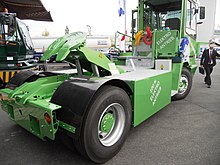Terminal tractor
A terminal tractor is a tractor for use in ports, logistics centers and industry. It is mainly used for handling semi-trailers , container chassis, roll trailers and heavy-duty trailers . Their purpose is comparable to that of a shunting locomotive in railway operations.
designation
Depending on the application, the vehicle is also called a RoRo tractor . Because of the adjustable fifth wheel, the designation lifting saddle tractor is also used.
Intended use
The main place of use of terminal tractors are ports. More than 1,000 vehicles of this type are on the road in very large facilities, for example in the Singapore freight port .
- In the case of RoRo ships , terminal tractors carry all vehicles on board, provided they do not drive onto the ship under their own power. This mainly includes semi-trailers and container chassis with one or two containers stacked on top of one another. Heavy and oversized loads are pulled on board by means of drawbar-guided heavy-duty trailers ; heaviest loads, such as power plant generators using gooseneck roll trailers.
- During loading and unloading of container ships in many ports for transport to the container bridges usually straddle or driverless transport vehicles used. In addition, and in ports where these vehicles are not available, terminal tractors and reach stackers are mainly used.
- Terminal tractors are also used in logistics and distribution centers to quickly move semi-trailers and container chassis. Vehicles with a longer wheelbase are also used to transport swap bodies .
- Because of the possible high trailer load and the robust construction, these vehicles are also used in industry, for example in foundries and steel works. Heavy loads are often pulled on roll trailers with iron wheels.
- Terminal tractors are also available as two-way vehicles for shunting rail wagons on tracks in the port area . In order to supply the compressed air braking system of the car, it is necessary to mount sufficiently dimensioned compressed air tanks on the tractor.
Terminal tractors are generally not used on public roads. Therefore, their use is not subject to the regulations of the Road Traffic Act or the provisions of the Road Traffic Licensing Regulations . These vehicles significantly exceed the total weights and axle loads specified in these regulations : Some terminal tractors are designed for total weights of 375 t . Also, they usually only reach a low speed and not the design-related maximum speed of 60 km / h required for using public roads ( § 18 StVO). Nevertheless, terminal tractors with a corresponding individual operating permit in accordance with Section 21 StVZO can also be used in road traffic in individual cases. For the BMW Group , for example, two electric vehicles drive between the Milbertshofen plant and logistics facilities in Garching and Karlsfeld .
Construction
Terminal tractors usually have a cab for only one person. On certain models, the driver's seat unit (including the steering wheel) can be rotated 180 degrees. This allows the driver to always have a direct view of the trailer when required, which facilitates both quick “parking” and safe and quick pulling out of loads, for example from the narrow hold of a ship. Therefore, all cabs have all-round glazing. In addition to a side driver's door, some models also have a rear sliding door that allows easy and safe access to the connections and cables of the towed unit without the driver having to leave the vehicle.
The robust chassis usually has a short wheelbase of around 3 meters. In contrast to tractor units , the fifth wheel couplings are height-adjustable: simply lifting them without the driver getting out and without the time-consuming cranking up of the front support legs allows the trailer to be repositioned quickly. The saddle plate is adjusted using one or more lifting cylinders , which can be operated from the driver's cab using a joystick . The fifth wheel is designed for a lifting load of up to 40 t .
As a rule, diesel engines are installed, usually with automatic transmissions . Some manufacturers also offer electric vehicles . The loading and unloading of RoRo ships takes place under great time pressure. Therefore, terminal tractors usually have a large fuel tank , whose contents sufficient without refueling an uninterrupted flow in the layer system to allow.
See also
Web links
- Mafi Distribution Tractor YouTube short film about how terminal tractors work. Published on April 15, 2014.
- Terminal tractors YouTube short film about terminal tractors in Zeebrugge. Published on March 14, 2015.
Individual evidence
- ↑ Lifting saddle tractors for freight forwarding, industry and ports . Website Rebensburger Fördertechnik . Retrieved March 3, 2019.
- ↑ Terberg Magazin Internet brochure Terberg , page 34. Retrieved on March 4, 2019.
- ↑ Roll trailers transport the heaviest loads . Multi-trans website . Retrieved February 12, 2019.
- ↑ BMW Group puts another electric YT 202-EV into operation Press release from a manufacturer of December 14, 2017, accessed on March 3, 2019.
- ↑ Implementing the semi-trailer (PDF; 148 kB) MAFI website . Retrieved March 4, 2019.




